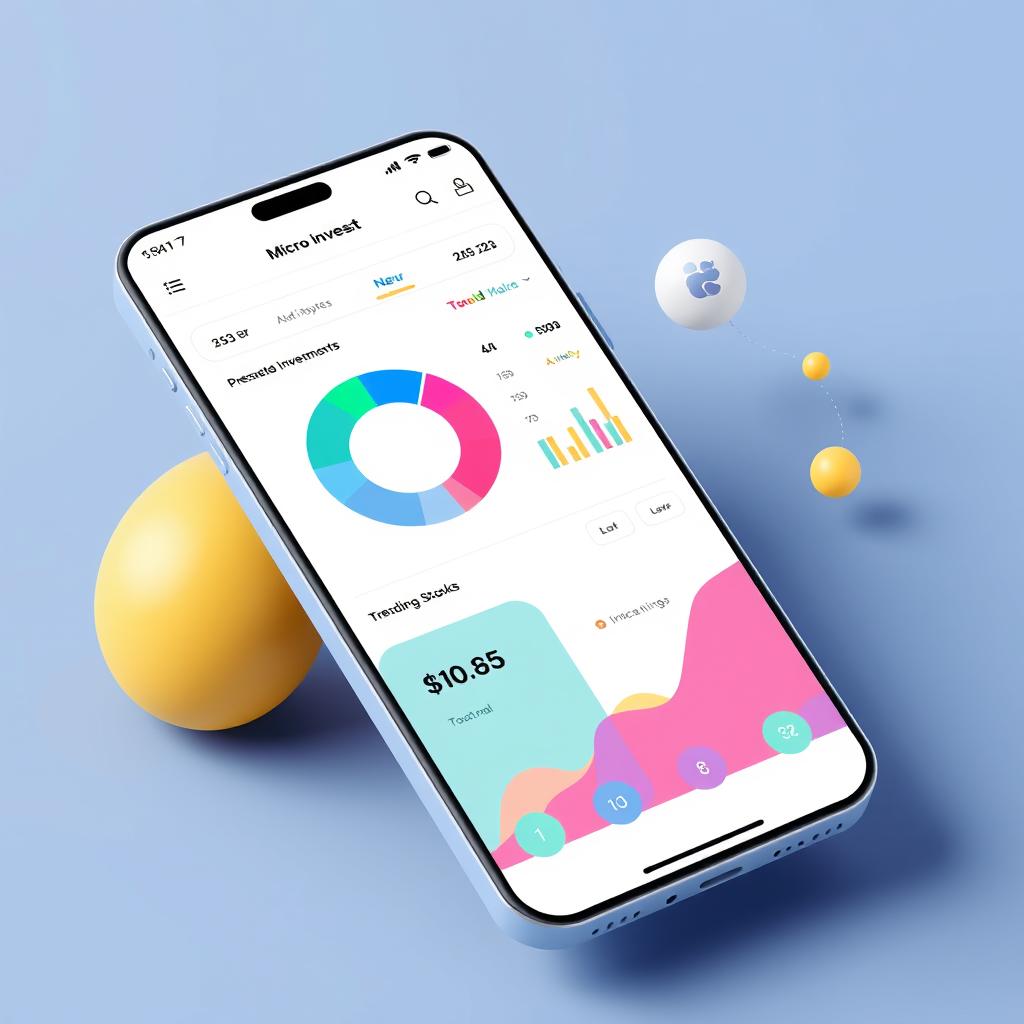How to Start Investing in the Stock Market with $100

Table of Contents
Did you know over 80% of Americans think investing in the stock market is key to financial freedom? Yet, many don’t start because they think they need a lot of money. But, starting your investment journey is possible with just $100.
The world of investing has changed a lot. Now, anyone can start investing without needing a lot of money. Online brokers offer free trading and no minimum balance, making it easy to start investing12.
Investing in fractional shares or using ETFs doesn’t need a lot of money. This article will show you how to start investing wisely. We’ll grow your money one dollar at a time.
Key Takeaways
- Investing in the stock market can begin with as little as $100.
- Zero fees for online equity trades make investing accessible.
- Fractional shares allow for investing in high-priced stocks without large sums.
- Retirement accounts like 401(k)s offer valuable employer contributions.
- Robo-advisors can automate investments based on individual needs.
- Investing in index funds can yield substantial long-term returns.
Understanding the Basics of Investing
Getting into the world of finance starts with understanding the basics of investing. Investments are assets bought with the hope they will make money or grow in value. Knowing how the stock market works helps me pick the right investments.
Compound interest is a key idea for investors. It makes my money grow fast over time. Starting early means I can earn a lot more, showing why it’s good to start investing early.
Spreading investments across different types is smart. This way, I can lower risks and maybe get better returns. For instance, mixing stocks, bonds, and real estate can keep my portfolio steady, even when the market changes.
| Investment Type | Minimum Investment | Time Horizon |
|---|---|---|
| Mutual Funds | Ranges from $500 to $5,000 or no minimum | Long-term |
| Hedge Funds | Average $1 million or higher | Long-term, typically 10 years+ |
| Certificates of Deposit (CDs) | Varies; money locked from months to years | Short to medium-term |
| Real Estate Investment Trusts (REITs) | Percentage of shares trades like stocks | Long-term |
| Exchange-Traded Funds (ETFs) | Tracks various indexes (e.g., S&P 500) | Short to long-term |
As a new investor, I’ll focus on these basics. I want to use compound interest to my advantage. Understanding these concepts will help me invest wisely.
“Invest in your future. It pays the best interest.”
Why $100 is a Great Starting Point

Starting with $100 is a smart move towards my financial goals. It lets me invest regularly without feeling stressed. This amount makes investing easy and accessible.
Studies show that most millionaires got there by investing consistently over time4. By putting in $100 each month, I can grow my money into a lot over the years.
The stock market usually makes 8% to 12% each year. It takes about 10 years to see good returns after investing consistently4. If I invest $100 monthly at a 10% return, I could have around $200,000 in 30 years4.
Dollar-cost averaging is a smart way to invest the same amount every time, no matter the market5. Also, reinvesting dividends can help my money grow even more5. With the growth of online businesses and e-learning, my $100 could lead to big opportunities6.
Investment Products Accessible with $100

Starting with $100 can kickstart my financial journey. This amount opens doors to various investment options, especially in low-cost investing. Fractional shares are a great choice, allowing me to invest in parts of stocks, not just whole ones.
Low-cost ETFs are another excellent option. They track indexes and often cost less than mutual funds. By buying one ETF share, I can invest in many stocks, stretching my budget further.
Let’s look at what a $100 investment can get me:
| Investment Product | Minimum Investment | Notes |
|---|---|---|
| Fractional Shares | $1 or less | Allows investment in high-priced stocks. |
| Low-Cost ETFs | Price of one share | Provides diversification with lower fees. |
| Mutual Funds | $100 and up | Minimums can vary significantly. |
| Money Market Accounts | Varies by institution | Offers higher interest rates compared to traditional savings. |
With $100, I have many investment choices. These options make the stock market more reachable and help me build a balanced portfolio early on.
Exploring these investment avenues is key. It lets me make smart choices without feeling overwhelmed.
In conclusion, the range of investment products with just $100 is exciting. I can confidently start my investing journey, knowing small steps can lead to big growth789.
Creating a Diverse Portfolio

In my journey toward effective portfolio management, I understand the importance of a diverse portfolio. Diversification strategies are key to managing risk. They ensure my investments aren’t too dependent on one sector or asset class.
Importance of Diversification
Diversification is a smart investment strategy. It spreads risk and captures gains from different markets or asset classes. Data shows that overreacting in market downturns can cause big losses, with 80% of damage done by the time an average investor reacts10.
By having a balanced portfolio, I can include a mix of investments. This mix has low or negative correlations, helping to offset downturns in specific sectors11.
Examples of Diversifying Investments
When building my diverse portfolio, I aim for 20 to 30 investments10. This makes it easier to monitor and rebalance my investments. I check my portfolio at least twice a year12.
Some common strategies include combining different asset types. For example:
- Stocks
- Bonds
- Real Estate Investment Trusts (REITs)
- Index Funds
Index funds often have low fees, helping me keep more money10. I also use dollar-cost averaging. This means investing money regularly to reduce risk10.
This strategy helps me stay committed to my long-term goals, even during market ups and downs.
Choosing the Right Investment Account

Starting my investment journey, selecting the right investment account is key. There are many types of accounts, each with its own benefits. For example, brokerage accounts offer flexibility, while IRAs provide tax perks13.
Many brokerage accounts don’t need a minimum balance to start14. This is great for beginners like me, offering a safe starting point.
It’s important to understand what each account offers. Traditional and Roth IRAs have different tax benefits to consider13. 529 savings plans are good for education, with tax-free withdrawals13. General investment accounts offer flexibility but come with tax issues to manage.
When choosing, I should look at fees like annual or inactivity charges14. Some brokerages offer free trades, saving me money14. It’s also useful to check if the account can be managed on my phone14.
My account selection must match my financial goals and strategy. Whether I choose a traditional IRA for tax benefits or a brokerage for flexibility depends on my plans. It’s crucial to pick an account that supports my goals, considering fees and investment choices15.
Retirement Accounts: A Wise Choice

Thinking about my future, I see how important retirement accounts are. They help me save for the long run. I can choose between a 401(k) or an IRA, both of which are key for my financial security. These accounts offer tax benefits that help my savings grow over time.
What is a 401(k)?
A 401(k) is a plan my employer offers for saving for retirement. I can set aside part of my paycheck before taxes are taken out. In 2024, I can contribute up to $23,000 to a 401(k), with an extra $7,500 if I’m 50 or older16.
Many employers also match my contributions. This means they give me free money to help grow my retirement savings16.
Understanding IRAs
IRAs are another way to save for retirement. There are two main types: traditional and Roth IRAs. A traditional IRA lets me save before taxes, while a Roth IRA requires after-tax contributions16.
The tax benefits are different too. Traditional IRAs give a tax deduction when I contribute. Roth IRAs offer tax-free withdrawals in retirement17. Knowing about these accounts helps me plan for a secure financial future.
Brokerage Accounts and How to Use Them

Opening a brokerage account is a key step for those new to stock trading. These accounts let you buy and sell investments. They also have features that help manage your account well. Many platforms now offer $0 commissions on equity trades, making trading more affordable18.
Brokerage accounts are also flexible, unlike retirement accounts. You can invest any amount without limits19. It’s important to know how to manage your account, including placing orders and tracking your investments.
Investments sold within a year may face short-term capital gains taxes. Yet, brokerage accounts are great for active investment management18. They’re also good for long-term investing and retirement savings19. Here’s a quick comparison of some key aspects of brokerage accounts:
| Feature | Brokerage Account | Retirement Account |
|---|---|---|
| Commission Fees | $0 | Varies |
| Account Minimum | $0 to promotions | Varies |
| Investment Flexibility | High | Limited |
| Capital Gains Tax | Yes, for short-term | Penalties for early withdrawal |
Brokerage accounts offer low fees, flexibility, and the chance to manage your financial future. They’re a great choice for anyone starting their investing journey.
Utilizing Micro-Investing Apps

Micro-investing apps have changed how I invest. They make it easy for anyone with a smartphone to start. I can invest with just $1 or the spare change from daily buys. It’s easy to add up small amounts without feeling overwhelmed.
These apps are super convenient. That’s why many new investors are drawn to them.
How Micro-Investing Works
Micro-investing apps use automated investing. I can invest a little bit at a time, like every week. This way, I can grow my portfolio slowly.
While it’s safer with smaller amounts, remember, there’s always a risk. It’s key to know the fees these apps charge. This helps me see how they affect my returns2021.
Popular Micro-Investing Platforms
Many apps offer different investment options. For example, Acorns lets you start with $5, and Robinhood with just $1. I’ve tried Stash and Betterment, which offer options for those who care about social responsibility2021.
It’s important to research these apps. They might not offer the same variety as traditional firms.
| Micro-Investing App | Minimum Investment | Key Features |
|---|---|---|
| Acorns | $5 | Automated roundups, diversified portfolios |
| Betterment | $10 | Automated investing, personalized advice |
| Robinhood | $1 | Fractional shares, commission-free trades |
| Fidelity | $1 | Access to fraction shares, no commission |
| Charles Schwab | $5 | Fractional shares, user-friendly interface |
Choosing the right app is key to a good investment strategy. Their ease and automation help me on my financial path2021.
Exchange-Traded Funds (ETFs) for Beginners

Starting out in investing, I’ve found ETFs to be a great choice. They offer a way to diversify my portfolio. ETFs are traded like stocks and cover different assets, making my investments varied. Plus, many ETFs, like Vanguard’s Consumer Staples ETF (VDC), only need a $1 investment, which is perfect for those starting with $10022.
ETFs track indexes, sectors, or commodities. They hold stocks or bonds. This makes it easy for me to diversify my investments. For example, the SPDR S&P 500 (SPY) tracks the S&P 500 Index, offering a simple way to invest in leading companies22.
ETFs have shown strong performance in areas like tech and cryptocurrency. The iShares Blockchain and Tech ETF, for instance, had a 74.35% return in one year. This shows ETFs can offer good returns23. But, I must remember they also have risks like trading costs and liquidity issues23.
It’s also important to watch how ETF trading prices can differ from the true value of the securities. This could affect my investment choices24. Overall, ETFs are a solid choice for beginners. They help me create a balanced portfolio that balances risk and return while investing wisely.
Investing in Individual Stocks

Exploring the world of investing, focusing on individual stocks is both thrilling and challenging. Buying individual stocks lets me directly profit from the growth of specific companies. For those with limited funds, fractional shares offer a way to invest in high-value companies without needing a lot of money. This makes stock research key to finding investments that match my financial goals.
Benefits of Buying Fractional Shares
Fractional shares let me buy a part of a pricey stock. This means I can diversify my investments even with a small budget. Investing in individual stocks can also mean lower fees than mutual funds and ETFs. This way, I can build a portfolio that fits me while keeping costs down25.
Researching Individual Companies
Doing deep stock research is crucial before investing in individual stocks. I need to look at a company’s financial health, its place in the industry, and its growth potential. While many investors might act on impulse due to market changes, sticking to a solid strategy is key to success. It takes time to watch my investments closely, making sure I’m making smart choices to boost my returns25 and avoid emotional trading risks26.
Utilizing Robo-Advisors for a Hands-Off Approach

Robo-advisors are great for those who don’t want to manage their investments themselves. They use automated systems to handle your money. The robo-advisor market was worth $7.39 billion in 2023 and is expected to grow even more. It’s set to reach $9.50 billion in 2024 and could hit $72 billion by 203227.
What makes robo-advisors appealing is how easy they are to use. You can start investing with as little as $0 to $500,00027. They also charge less than traditional financial advisors, with fees ranging from 0.25% to 0.50% a year28.
Platforms like Betterment and Wealthfront offer more than just portfolio management. They keep an eye on your investments all the time. They use software to adjust your portfolio based on market changes, including rebalancing and tax-loss harvesting28. Their portfolios are mostly ETFs, following Modern Portfolio Theory to manage risk without aiming for top returns.
Risk Management and Investment Strategies

Managing risk is key for anyone in the world of investing. Investing always carries risks, and knowing the risk-return balance is crucial. My risk tolerance is shaped by my capacity, needs, and emotions29. When I invest, I make sure my plans consider these aspects.
Understanding Risk vs. Return
Finding the right balance between rewards and risks is central in financial planning. I spread my investments across different areas to avoid big losses29. This approach helps reduce risks and is vital during economic ups and downs30. I also set a plan for maximum losses to keep my investments on track29. The standard deviation helps me measure risk, which is important in managing investments31.
Setting Realistic Financial Goals
Setting realistic financial goals is a big part of my investment plan. I use software to check my risk level and adjust my investments29. Dollar-cost averaging is another strategy I use, where I invest the same amount regularly to lower risks29. By understanding beta and alpha, I can see how much risk I’m taking and the extra returns31. Regularly checking and adjusting my investments helps me stay on track with my goals, even when the market changes30.
Capital Gains and Dividend Income Explained

When I invest in stocks, it’s key to know the difference between capital gains and dividend income. Capital gains happen when I sell an investment for more than I bought it for. Dividend income comes from owning shares in companies that share profits with shareholders. Investments held for over a year get taxed at lower rates, known as long-term capital gains tax rates.
In the U.S., these tax rates range from 0% to 28% based on the type of gain32.
For instance, qualified dividends are taxed the same as long-term capital gains. This makes them a good income source32. Companies pay dividends at various times, like quarterly or annually. It’s interesting that higher dividend yields often come from conservative industries like utilities and real estate33.
Knowing these details helps me track my investments’ performance and potential investing returns. If I reinvest my dividends, it can grow the number of shares I own. This can boost my earnings over time. Both capital gains and dividend income are crucial for reaching my financial goals, considering taxes at both federal and state levels32.
Creating a Long-Term Investment Plan

Creating a long-term investment plan is key for my financial growth. It helps me track my goals, manage risks, and make smart choices. First, I assess my investment timeline. This decides the investments I’ll choose.
Knowing my risk tolerance is also crucial. Investments vary in risk, which can impact returns. For example, growth stocks offer high returns but can be very volatile. My plan should match my risk comfort level, avoiding too much risk.
It’s important to regularly review and adjust my plan. My life and financial goals can change. This flexibility keeps me on track with my goals and ensures my investments support my long-term security.
Using strategies like dollar-cost averaging can improve my plan. This method involves investing a fixed amount regularly. It helps manage timing risks and keeps me committed to my strategy, even with market ups and downs. Investing has risks, but I’m hopeful about the long-term benefits.
| Investment Factors | Consideration |
|---|---|
| Investment Timeline | Determine how long I plan to invest |
| Risk Tolerance | Evaluate my comfort level with investment risks |
| Goals Review | Regularly assess and adjust financial goals |
| Investment Strategies | Implement approaches like dollar-cost averaging |
| Market Awareness | Stay informed about market conditions and trends |
By considering these factors, I can build a strong long-term investment plan. It aims for financial growth and prepares me for any market changes. This plan should meet my unique needs and help me achieve financial stability3435.
Conclusion
Starting my investing journey with just $100 can lay a strong foundation for future financial success. By using key investing principles, I can explore various products and implement effective strategies. This paves the way for rewarding experiences in the world of investing.
Every investment decision I make carries a certain level of uncertainty. This highlights the importance of continuously monitoring and assessing my portfolio to manage risks effectively36. Using tools like real options concepts by investing in education and opportunities for growth can further enrich my understanding and decision-making, particularly in volatile markets37.
To truly achieve financial independence, I must remain committed to learning and adapting my strategies. I must navigate the complexities of investing. The key to success lies in making informed choices that align with my long-term objectives. Keeping a flexible approach in the face of uncertainty is crucial as I start investing36 and grow my portfolio toward the goals I envision.
FAQ
How can I start investing in the stock market with just 0?
Start by opening a brokerage account. Look into fractional shares and low-cost ETFs. These options let you diversify your portfolio without needing a lot of money.
What are the basic principles of investing I should know?
Learn about compound interest, diversification, and risk management. These basics help you make smart investment choices and set financial goals.
What are the benefits of diversifying my investment portfolio?
Diversification spreads risk across different assets. This can reduce losses if one investment does poorly. It’s key for stable returns and reaching long-term goals.
What types of investment accounts should I consider?
Choose between brokerage accounts for flexibility and retirement accounts like IRAs and 401(k)s for tax benefits. Think about your investment strategy and financial situation before picking an account.
Are robo-advisors a good option for new investors?
Yes, robo-advisors are great for beginners. They create a portfolio based on your risk tolerance and goals. They often use low-fee ETFs.
How can I use micro-investing apps to start my investing journey?
Apps like Acorns and Stash let you invest small amounts regularly. They can grow your investment over time without needing a lot of money upfront.
What should I know about capital gains and dividend income?
Capital gains happen when you sell an investment for more than you bought it for. Dividend income comes from owning stocks that pay out earnings. Both are key for understanding investment performance.
Why is a long-term investment plan important?
A long-term plan keeps you focused on your financial goals. Regularly reviewing and adjusting it ensures your investments match your objectives.
What are the potential risks I should be aware of in investing?
All investments have some risk. Higher returns often mean higher risk. Knowing this helps you manage your investments well and reach your financial goals.
Source Links
- https://www.nerdwallet.com/article/investing/how-to-invest-100
- https://www.fool.com/investing/how-to-invest/how-to-invest-100-dollars/
- https://www.investopedia.com/articles/basics/11/3-s-simple-investing.asp
- https://www.forbes.com/sites/pattieehsaei/2023/10/12/you-can-afford-to-invest-start-with-just-100-per-month/
- https://www.investopedia.com/articles/investing/110615/investing-100-month-stocks-20-years.asp
- https://amrich.medium.com/how-to-turn-100-into-1-000-in-24-hours-or-less-3c937fa0abf
- https://www.bankrate.com/investing/best-compound-interest-investments/
- https://www.fidelity.com/fixed-income-bonds/overview
- https://www.investopedia.com/terms/m/minimum_investment.asp
- https://www.investopedia.com/articles/03/072303.asp
- https://www.fidelity.com/viewpoints/investing-ideas/guide-to-diversification
- https://www.bankrate.com/investing/tips-for-diversifying-your-portfolio/
- https://investor.vanguard.com/investor-resources-education/how-to-invest/investment-accounts
- https://fortune.com/recommends/investing/how-to-open-an-investment-account/
- https://www.nerdwallet.com/article/investing/types-investment-accounts-know
- https://www.bankrate.com/retirement/best-retirement-plans/
- https://www.nerdwallet.com/article/investing/best-retirement-plans-for-you
- https://www.nerdwallet.com/article/investing/what-is-how-to-open-brokerage-account
- https://www.schwab.com/brokerage/what-is-a-brokerage-account
- https://www.desertfinancial.com/en/learn/blog/financial-education/micro-investing-apps/
- https://www.britannica.com/money/what-is-micro-investing
- https://www.investopedia.com/terms/e/etf.asp
- https://www.nerdwallet.com/article/investing/how-to-invest-in-etf-exchange-traded-fund
- https://www.ally.com/stories/invest/etfs-for-beginners/
- https://www.investopedia.com/articles/investing/072915/single-stocks-your-portfolio-pros-and-cons.asp
- https://www.nerdwallet.com/article/investing/how-to-invest-in-stocks
- https://www.investopedia.com/articles/personal-finance/010616/pros-cons-using-roboadvisor.asp
- https://www.investopedia.com/are-robo-advisors-worth-it-7568057
- https://www.sofi.com/learn/content/investment-risk-management/
- https://www.forbes.com/sites/investor-hub/2023/08/12/best-risk-management-strategies-for-2023/
- https://www.investopedia.com/terms/r/riskmanagement.asp
- https://www.investopedia.com/ask/answers/033015/there-difference-between-capital-gains-and-dividend-income.asp
- https://www.thriventfunds.com/insights/mutual-fund-focus/why-are-dividends-capital-gains-mutual-funds-important.html
- https://www.schwab.com/learn/story/guide-to-long-term-investment-strategies
- https://www.bankrate.com/investing/best-long-term-investments/
- https://saylordotorg.github.io/text_developing-new-products-and-services/s17-08-conclusion.html
- https://nap.nationalacademies.org/read/9075/chapter/10






